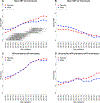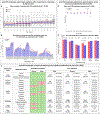Sex Differences in Hypertension and Its Management Throughout Life
- PMID: 39229711
- PMCID: PMC11483212
- DOI: 10.1161/HYPERTENSIONAHA.124.22980
Sex Differences in Hypertension and Its Management Throughout Life
Abstract
Background: The prevalence of hypertension and uncontrolled hypertension may differ by age and sex.
Methods: We included participants in the Atherosclerosis Risk in Communities study at seven study visits over 33 years (visit 1: 15 636 participants; mean age, 54 years; 55% women), estimating sex differences in prevalence of hypertension (systolic blood pressure ≥130 mm Hg; diastolic blood pressure ≥80 mm Hg; or self-reported antihypertension medication use) and uncontrolled hypertension (systolic blood pressure ≥140 mm Hg or diastolic blood pressure ≥90 mm Hg) using unadjusted and comorbidity-adjusted models.
Results: The prevalence of hypertension increased with age from 40% (ages, 43-46 years) to 93% (ages, 91-94 years). Within hypertensive individuals, the prevalence of uncontrolled hypertension was higher in men (33%) than women (23%) at ages 43 to 46 years but became higher in women than men starting at ages 61 to 64, with 56% of women and 40% men having uncontrolled hypertension at ages 91 to 94. This sex difference was not explained by differences in coronary heart disease, diabetes, body mass index, estimated glomerular filtration rate, number of antihypertension medications, classes of medications, or adherence to medications. In both sexes, uncontrolled hypertension was associated with a higher risk for chronic kidney disease progression (hazard ratio, 1.5 [1.2-1.9]; P=4.5×10-4), heart failure (hazard ratio, 1.6 [1.4-2.0]; P=8.1×10-7), stroke (hazard ratio, 2.1 [1.6-2.8]; P=1.8×10-8), and mortality (hazard ratio, 1.5 [1.3-1.6]; P=6.2×10-19).
Conclusions: Sex differences in the prevalence of hypertension and uncontrolled hypertension vary by age, with the latter having implications for health throughout the life course.
Keywords: health; hypertension; medication adherence; sex characteristics.
Conflict of interest statement
The data reported here have been supplied by the United States Renal Data System (USRDS). The interpretation and reporting of these data are the responsibility of the author(s) and in no way should be seen as an official policy or interpretation of the US government. USRDS data were used for Table 3. The opinions presented do not necessarily represent those of the National Institute of Diabetes and Digestive and Kidney Diseases, the National Institutes of Health, the Department of Health and Human Services, or the US Government. The interpretation and reporting of these data are the responsibility of the authors and in no way should be seen as an official policy or interpretation of the US Government.
Figures


References
-
- Global report on hypertension: the race against a silent killer. www.who.int. Published September 19, 2023. https://www.who.int/publications/i/item/9789240081062
Publication types
MeSH terms
Substances
Grants and funding
LinkOut - more resources
Full Text Sources
Medical

